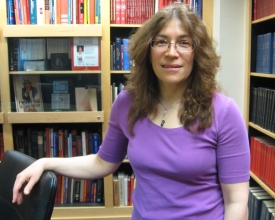By Jane Erikson | UA College of Medicine – Tucson
August 18, 2015 | UA@Work | Lo Que Pasa
 When she was 5, Julia Indik, MD, PhD, wanted to be an astronaut – something a lot of kids want to be. But over time, her longing for space adventure evolved into a passion for math and physics and, as she says, "one thing led to another." Most notably, it led her to the UA College of Medicine, where she received her medical degree in 1996.
When she was 5, Julia Indik, MD, PhD, wanted to be an astronaut – something a lot of kids want to be. But over time, her longing for space adventure evolved into a passion for math and physics and, as she says, "one thing led to another." Most notably, it led her to the UA College of Medicine, where she received her medical degree in 1996.
Now a cardiologist with the UA Department of Medicine, a UA Sarver Heart Center member and a specialist in heart arrhythmias, Indik holds the Flinn Foundation and American Heart Association Endowed Chair in Electrophysiology. She was promoted July 1 to full professor.
It's been a remarkable journey.
Indik grew up in New York City and got her bachelor's degree in astrophysics from Princeton, followed by a doctorate in physics, with a focus on astrophysics, at the Massachusetts Institute of Technology.
"Astronomy was just kind of nifty," she explained, "and one thing led to another."
Her studies at MIT led her to the UA's Steward Observatory, where she was a post-doc research associate from 1986 to 1989. She followed that with a two-year, informal post-doc at the UA Lunar and Planetary Laboratory.
It was work she loved. But in graduate school, and during her time at the UA, she realized that even while probing such mysteries as the dynamics of galaxies and the movement of planets – topics she explored with her mentor, astronomer Simon White – astronomy was not for her a sustainable pursuit.
The fact that the UA also had a medical school was not lost on Indik when she decided to come to the University for her post-doc, and before she finished her work at Steward, she decided she wanted to be a doctor. The moment of decision came when she was expecting her first baby.
"It was the first time I had to see a doctor on a regular basis," Indik recalled. "My obstetrician was such a fabulous doctor, and so sensitive to my concerns. I thought, 'Oh my gosh, if I could just do that.'"
In 1991, she was admitted to the UA College of Medicine. She took an extra year to do research in radiation oncology, through the college's Medical Student Research Program. It was work that she enjoyed. She and her husband, UA mathematician Robert Indik, developed a computer-based model to predict heating in tumors treated by radiation therapy.
Their experience led to two publications. It also convinced Indik that she wanted her medical career to include more interaction with patients.
At first drawn to obstetrics and gynecology, then neurology and neurosurgery, it was when she did her internal medicine rotation that she found "all the fun stuff – puzzle solving, thinking about the whole picture, putting all the facts together to figure out what's going on with the patient."
One of her mentors was Frank I. Marcus, MD, former chief of cardiology in the Department of Medicine, and an expert in electrophysiology. He is widely known for his research in heart arrhythmias and his pioneering work with cardiac ablation to treat arrhythmias.
In 2002, Indik graduated from the Department of Medicine's Cardiovascular Disease Fellowship program. She realized her physics background would be a good match for a career in electrophysiology, but there was no fellowship for this highly specialized training in Tucson.
And she did not want to have to leave her husband and children behind to train elsewhere.
Marcus came up with the solution.
"Frank pushed to get an accredited electrophysiology fellowship program here in Tucson to basically just train me," Indik recalled.
"I can't say enough amazing things about Dr. Frank Marcus," she said. "He has been there to support my career at every step. He has involved me in research and introduced me to leaders in our field, which has further led to other opportunities in my career. And everyone I meet at national conferences, when they hear I am at the University of Arizona, asks about Frank. He is loved by many."
The admiration was, and is, mutual.
"She was exceptionally well-qualified to go into electrophysiology," Marcus said. "She's a very personable individual, she's very forthright and has very good relations with her patients, and she's a very competent physician and electrophysiologist. I'm very pleased that she's stayed with us and gone on to be a full professor."
Mindful of how important mentors were to her, Indik welcomes medical students who come to her seeking information and advice.
"I want to give back to my college," she said. "I am delighted to give any advice I can when a student comes to me. I tell all students, 'Don’t let anyone tell you what you can and cannot do.'"
Last week, Indik received a card in the mail from a patient in whom she implanted a pacemaker a couple of months ago. "He told me that he was so grateful for my care, for taking the time to explain things. I can’t tell you how touched I was to receive a personal card like that – especially in an age where we hardly ever take the time to actually write a personal letter to anyone.
"I went into medicine, and into cardiology, for a lot of reasons. It's a great fit to my abilities, to how I think, how I analyze problems and come up with solutions. But the human factor grabs my heart. Every time."

